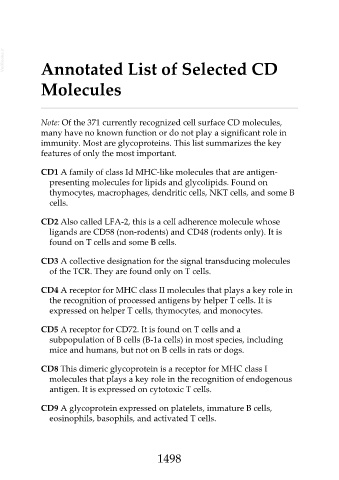Page 1498 - Veterinary Immunology, 10th Edition
P. 1498
VetBooks.ir Annotated List of Selected CD
Molecules
Note: Of the 371 currently recognized cell surface CD molecules,
many have no known function or do not play a significant role in
immunity. Most are glycoproteins. This list summarizes the key
features of only the most important.
CD1 A family of class Id MHC-like molecules that are antigen-
presenting molecules for lipids and glycolipids. Found on
thymocytes, macrophages, dendritic cells, NKT cells, and some B
cells.
CD2 Also called LFA-2, this is a cell adherence molecule whose
ligands are CD58 (non-rodents) and CD48 (rodents only). It is
found on T cells and some B cells.
CD3 A collective designation for the signal transducing molecules
of the TCR. They are found only on T cells.
CD4 A receptor for MHC class II molecules that plays a key role in
the recognition of processed antigens by helper T cells. It is
expressed on helper T cells, thymocytes, and monocytes.
CD5 A receptor for CD72. It is found on T cells and a
subpopulation of B cells (B-1a cells) in most species, including
mice and humans, but not on B cells in rats or dogs.
CD8 This dimeric glycoprotein is a receptor for MHC class I
molecules that plays a key role in the recognition of endogenous
antigen. It is expressed on cytotoxic T cells.
CD9 A glycoprotein expressed on platelets, immature B cells,
eosinophils, basophils, and activated T cells.
1498

